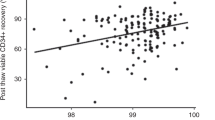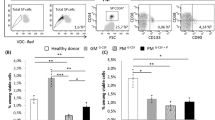Summary:
Taking advantage of fluorescent substrates for their metabolic marker aldehyde dehydrogenase (ALDH), hematopoietic stem cells (HSC) were defined as SSCloALDHbr – reflecting their low orthogonal light scattering and bright fluorescence intensity in flow cytometry. Based thereon, we investigated the usefulness of ALDH activity for characterizing HSC graft quality, particularly under stress conditions. We first compared the expression of ALDH vs CD34 in bone marrow and peripheral blood stem cell (PBSC) samples over 7 days. We noted that (i) only ALDH activity but not CD34 expression strongly reflected colony-forming ability over time, and that (ii) PBSC grafts stored at room temperature lost most of their progenitor cells within just 48 h. We then retrospectively related ALDH and CD34 expression as well as granulocyte–macrophage colony-forming units (CFU-GM) potential for 19 cryopreserved allogeneic PBSC grafts to engraftment data. Strikingly, in all six patients who received markedly decreased numbers of SSCloALDHbr cells, this was associated not only with almost complete loss of CFU-GM potential but also with delayed establishment/permanent absence of full hematopoietic donor cell chimerism, whereas all other patients showed early complete donor chimerism. In conclusion, we suggest to measure ALDH activity as a surrogate marker for HSC activity, and to transport and store PBSC under controlled cooling conditions.
This is a preview of subscription content, access via your institution
Access options
Subscribe to this journal
Receive 12 print issues and online access
$259.00 per year
only $21.58 per issue
Buy this article
- Purchase on Springer Link
- Instant access to full article PDF
Prices may be subject to local taxes which are calculated during checkout


Similar content being viewed by others
References
Kohn FR, Sladek NE . Aldehyde dehydrogenase activity as the basis for the relative insensitivity of murine pluripotent hematopoietic stem cells to oxazaphosphorines. Biochem Pharmacol 1985; 34: 3465–3471.
Kastan MB, Schlaffer E, Russo JE et al. Direct demonstration of elevated aldehyde dehydrogenase in human hematopoietic progenitor cells. Blood 1990; 75: 1947–1950.
Jones RJ, Barber JP, Vala MS et al. Assessment of aldehyde dehydrogenase in viable cells. Blood 1995; 85: 2742–2746.
Storms RW, Trujillo AP, Springer JB et al. Isolation of primitive human hematopoietic progenitors on the basis of aldehyde dehydrogenase activity. Proc Natl Acad Sci USA 1999; 96: 9118–9123.
Hess DA, Meyerrose TE, Wirthlin L et al. Functional characterization of highly purified human hematopoietic repopulating cells isolated based on aldehyde dehydrogenase activity. Blood 2004; 104: 1648–1657.
Fallon P, Gentry T, Balber AE et al. Mobilized peripheral blood SSCloALDHbr cells have the phenotypic and functional properties of primitive haematopoietic cells and their number correlates with engraftment following autologous transplantation. Br J Haematol 2003; 122: 99–108.
Li Z, Fehse B, Schiedlmeier B et al. Persisting multilineage transgene expression in the clonal progeny of a hematopoietic stem cell. Leukemia 2002; 16: 1655–1663.
Stockschläder M, Hassan HT, Krog C et al. Long-term follow-up of leukaemia patients after related cryopreserved allogeneic bone marrow transplantation. Br J Haematol 1997; 96: 382–386.
Fehse N, Fehse B, Kröger N et al. Influence of anti-thymocyte globulin as part of the conditioning regimen on immune reconstitution following matched related bone marrow transplantation. J Hematother Stem Cell Res 2003; 12: 237–242.
Philpott NJ, Turner AJ, Scopes J et al. The use of 7-amino actinomycin D in identifying apoptosis: simplicity of use and broad spectrum of application compared with other techniques. Blood 1996; 87: 2244–2251.
Fehse B, Uhde A, Fehse N et al. Selective immunoaffinity-based enrichment of CD34+ cells transduced with retroviral vectors containing an intracytoplasmatically truncated version of the human low-affinity nerve growth factor receptor (ΔLNGFR) gene. Human Gene Ther 1997; 8: 1815–1824.
Pettengell R, Woll PJ, O'Connor DA et al. Viability of haemopoietic progenitors from whole blood, bone marrow and leukapheresis product: effects of storage media, temperature and time. Bone Marrow Transplant 1994; 14: 703–709.
Hechler G, Weide R, Heymanns J et al. Storage of noncryopreserved periphered blood stem cells for transplantation. Ann Hematol 1996; 72: 303–306.
Dyson PG, Hayes D, Rawling TP et al. Temperature monitoring – a step towards control of stem cell product during transport. (ISCT abstract) http://www.celltherapy.org/Abstracts2004.
Acknowledgements
This work has been financially supported by the Hamburger Krebsgesellschaft, the Fördergemeinschaft Kinder-Krebs-Zentrum Hamburg e.v. and the Dieter-Schlag-Stiftung. We thank J Schulz for her help with clinical data and Francis A Ayuk for critical reading of this paper.
Author information
Authors and Affiliations
Corresponding author
Rights and permissions
About this article
Cite this article
Lioznov, M., Freiberger, P., Kröger, N. et al. Aldehyde dehydrogenase activity as a marker for the quality of hematopoietic stem cell transplants. Bone Marrow Transplant 35, 909–914 (2005). https://doi.org/10.1038/sj.bmt.1704928
Received:
Accepted:
Published:
Issue Date:
DOI: https://doi.org/10.1038/sj.bmt.1704928
Keywords
This article is cited by
-
Foreskin-derived mesenchymal stromal cells with aldehyde dehydrogenase activity: isolation and gene profiling
BMC Cell Biology (2018)
-
Infectious dengue vesicles derived from CD61+ cells in acute patient plasma exhibited a diaphanous appearance
Scientific Reports (2015)
-
Infused neutrophil dose and haematopoietic recovery in patients undergoing autologous transplantation
Bone Marrow Transplantation (2014)
-
Factors predicting haematopoietic recovery in patients undergoing autologous transplantation: 11-year experience from a single centre
Annals of Hematology (2014)
-
Is it time to revisit our current hematopoietic progenitor cell quantification methods in the clinic?
Bone Marrow Transplantation (2012)



